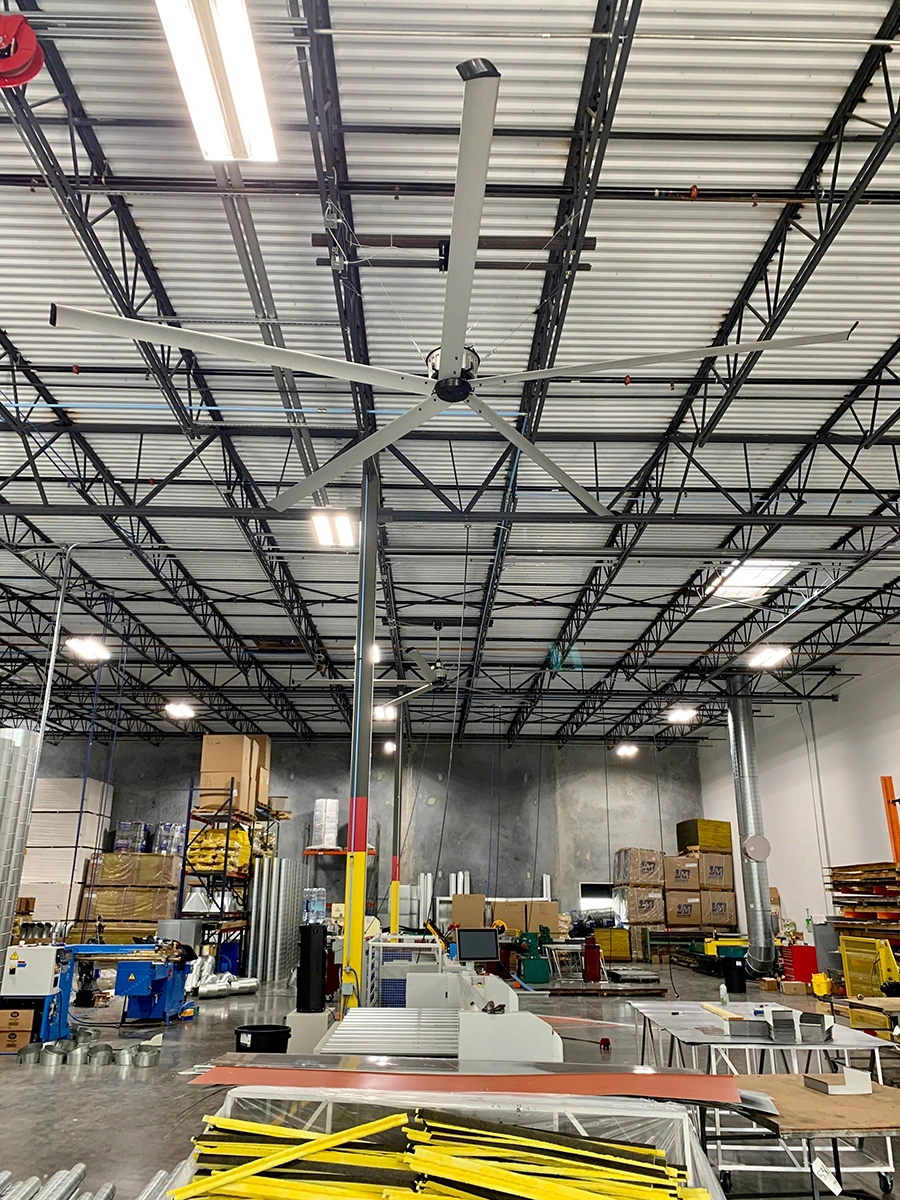
High-Volume Low-Speed (HVLS) ceiling fans enhance industrial workplaces by maintaining comfort with minimal noise. Their advanced engineering surpasses basic mechanics, improving energy efficiency and increasing productivity.
The Fundamental Physics of Air Movement
The fundamental knowledge of fluid dynamics forms the basis for HVLS fan technology, contradicting established methods of cooling and air circulation. Large-diameter fans differ from standard fans because they utilize a method of moving vast amounts of air while keeping rotations at minimal speeds.
Engineers refer to this airflow pattern as laminar since the smooth air movement from large-diameter fans enables coverage of wide areas without producing disruptive wind turbulence. The fans create powerful air displacement through their design, which results in an extraordinary “wind chill effect” that significantly changes warehouse climate conditions.
Thermodynamic Principles in Action
The scientific foundation of these fans is deeply rooted in thermodynamic principles. In large, enclosed spaces like warehouses, air naturally stratifies—warmer air rises to the ceiling while cooler air remains near the ground. This stratification creates significant challenges for temperature management and energy efficiency.
The active mixing of natural stratification patterns by HVLS fans leads to uniform temperature profiles, which lowers operational heating and cooling expenses by as much as 30%. These fans operate through slow and consistent airflow movements of large air volumes, creating an ecological balance that tests existing climate control systems.
The Intricate Engineering Behind HVLS Fans
HVLS fans of today represent engineering brilliance through their implementation of modern materials together with advanced design principles above ordinary fan manufacture techniques. The blades represent a well-calculated combination of weight distribution, together with aerodynamics and material durability.
Both CAD and CFD play a vital component in developing fans through their importance in design and simulation processes. Engineers leverage advanced modeling techniques through software to design airflow patterns before any initial prototypes are built, which optimizes efficiency throughout the entire development process.
Energy Efficiency: A Comprehensive Approach
HVLS fans today demonstrate the highest standard of energy-efficient development because of their advanced designs. The specific combination of motor technology advancements and aerodynamically designed blades allows these fans to use small amounts of electricity while providing strong air circulation. One 24-foot HVLS fan spans 20,000 square feet when effectively distributing air despite requiring only a single productive device in this expansive space.
Economic and Environmental Implications
The economic benefits of HVLS fans extend far beyond immediate energy savings:
- Significant reduction in HVAC system load
- Lower maintenance costs for climate control equipment
- Reduced wear and tear on mechanical systems
- Decreased overall energy consumption
- Substantial reduction in industrial facilities’ carbon footprint
Workplace Transformation: Beyond Temperature Control
The impact of HVLS fans transcends simple temperature management. Consistent air movement delivers multifaceted benefits:
- Reduces perceived temperature by 7-11 degrees
- Mitigates humidity-related discomfort
- Helps manage and improve indoor air quality
- Creates a more consistent and comfortable working environment
- Enhances worker productivity and well-being
In agricultural settings, these fans help manage livestock comfort. Manufacturing facilities benefit from reduced heat stress, while distribution centers maintain optimal conditions for both workers and stored goods.
Technological Innovations in Fan Design
Contemporary HVLS fans incorporate modern technologies that demonstrate remarkable engineering sophistication:
- Lightweight composite materials reduce fan weight while maintaining structural integrity.
- Precision-balanced blade designs minimize vibration.
- Smart control systems enable automated speed adjustments.
- Integrated sensors provide real-time performance and environmental data.
- IoT-enabled monitoring capabilities for predictive maintenance.
Noise Reduction and Aesthetic Considerations
Industrial fans traditionally create high noise, but HVLS fans generate minimal sound because of their slow-moving blades. The massive quiet blades from HVLS units produce minimal sound when in motion which makes these fans suitable for areas needing both peace and sufficient airflow.
Installation and Performance Optimization
Successful HVLS fan implementation requires more than just purchasing a unit. Proper installation involves detailed site analysis, considering factors like:
- Ceiling height and structural integrity
- Existing HVAC systems
- Specific operational requirements
- Airflow patterns unique to the facility
Professional assessment ensures optimal fan placement, maximizing performance and energy efficiency.
Refresh Fans: Pioneering Industrial Air Circulation
When it comes to transforming industrial environments, Refresh Fans stands at the forefront of HVLS technology. Our engineered solutions aren’t just fans—they’re comprehensive air management systems designed to elevate workplace efficiency.
Each Refresh Fans HVLS model represents a perfect fusion of scientific precision and practical innovation. Our company operates beyond basic air stream manipulation by optimizing complete environmental systems. The same commitment to excellence which goes into creating our fans results in their outstanding delivery of performance alongside energy efficiency and durability.
Experience the Refresh Fans difference: where modern engineering meets practical industrial solutions.